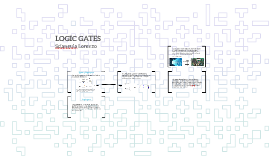LOGIC GATES
Transcript: Types of logic gate LOGIC GATES A logic gates is a circuit which carries out a very specific task based on simple logic. It looks at two bits of data which arrive (the input data), compares them and produces a result (the output) by following precise instructions. By putting them together in carefully planned sequences, so that the output from one becomes the input into another, it is possible to solve complex mathematical or logical problems. This approach is easily adapted to the binary system of digital processing used in a microprocessor. Because of the speed of its processing power, it is able to flash through vast numbers of these logical steps and arrive at a solution almost instantaneously. Sciangula Lorenzo The diagrams show the seven most common types of logic gate. The table next to each diagram shows what the output is for all possible inputs. 1 indicates an electrical input/output which is switched on. 0 indicates an electrical input/output which is switched off. The logical rules are based on Boolean algebra, developed by the British mathematician George Boole in the 1840s. Boolean algebra makes it possible to break down complicated problems into a series of small steps, each of which can be analysed using a simple "true/false" question. Logic gate Example: There are different types of logic gate, each with its own particular instructions.

















